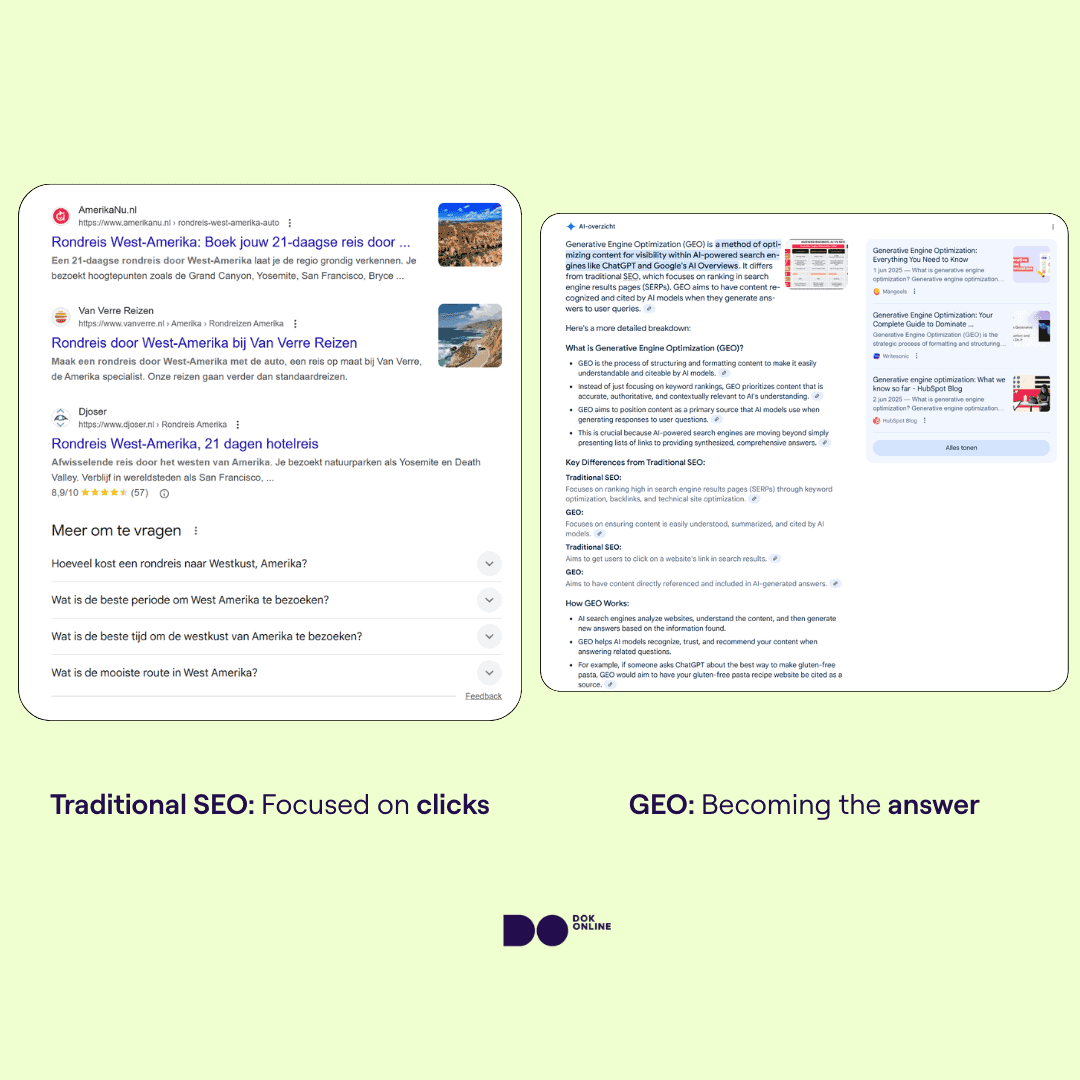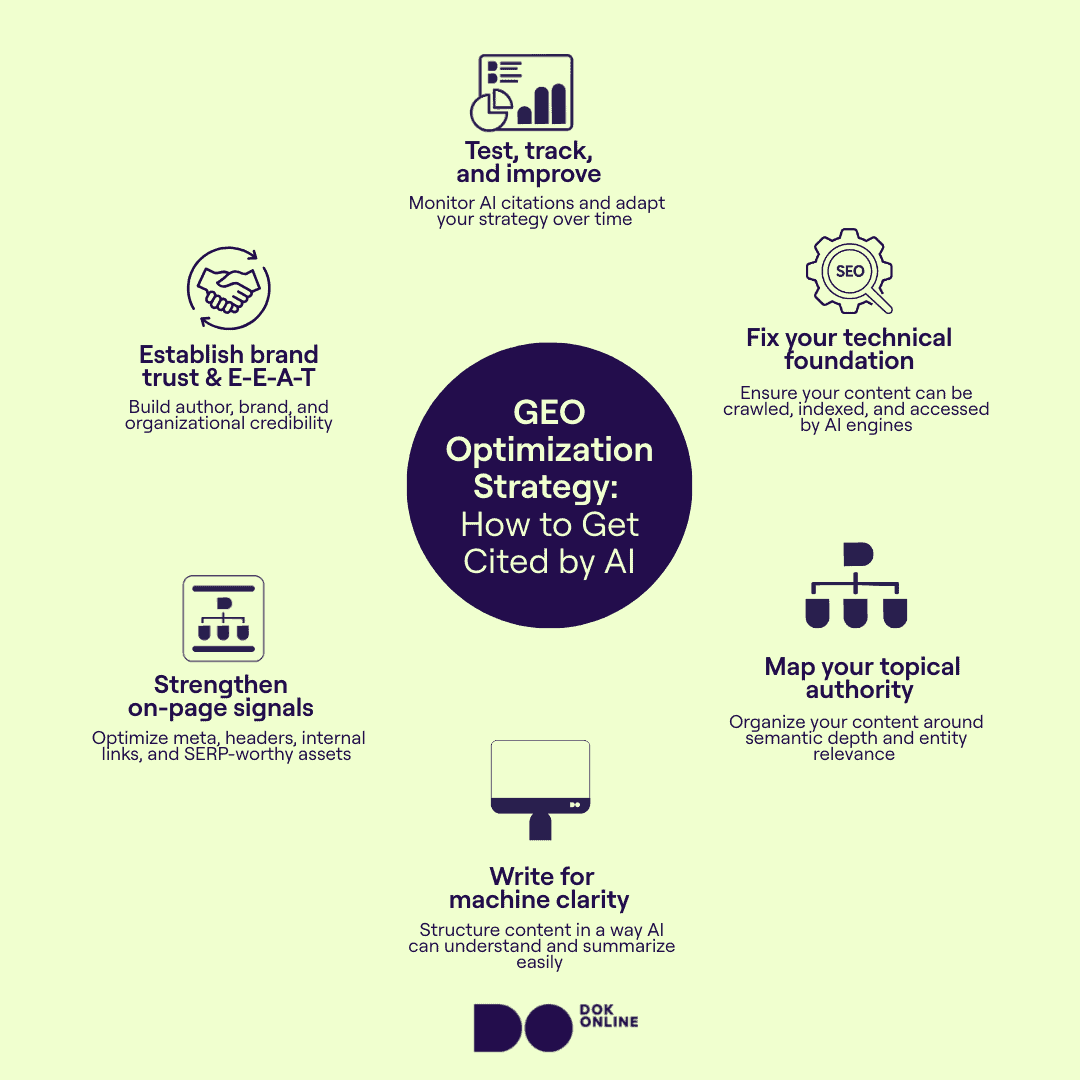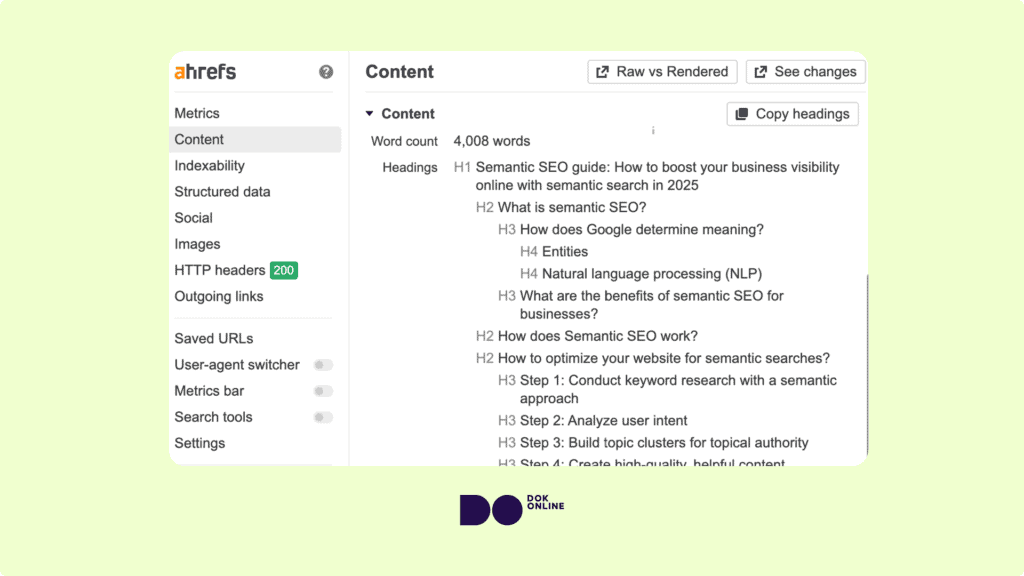From SEO to GEO: Generative Engine Optimization in 2026
Generative Engine Optimization (GEO) is the evolution of SEO in an age where AI-driven search machines respond with their own answers. Answer engines like Google SGE, ChatGPT, and Perplexity are reshaping search behavior, replacing traditional blue links with AI-generated overviews that change how users consume information.
As zero-click experiences become the norm, your brand’s ability to thrive online depends on how well your content is structured for generative AI search engines. GEO is the strategic response to how businesses need to stay competitive in AI powered search engines. In this guide, we’ll define what GEO is and how it works. Then we’ll show you how to adapt your GEO strategies to become visible.
What is Generative Engine Optimization (GEO)?
Generative Engine Optimization (GEO) is the process of structuring your content so that AI search engines can retrieve, understand, and cite it in their answers.
Unlike optimizing for traditional search engines where the name of the game is ranking, GEO focuses on being selected as part of an AI’s direct response to a user query. For example, when someone asks Perplexity about the best email marketing tools, the model may quote your blog if your content fits the AI’s criteria. That’s the new win.
As generative AI search engines gain traction, the world of digital marketing is shifting its focus from clicks to citations. Users now get full answers in a single view on multiple touchpoints, often without visiting a website. Users can still click through for more detail but increasingly, they don’t need to.
The shift to generative AI-driven search engines means your content needs to work differently. It must now be for the algorithms to rank, people to engage with, and large language models to synthesize information.
GEO sits within a broader shift toward answer engine optimization (AEO), where structured, fact-based content becomes the fuel for AI-generated insights. Up next, we’ll explore why this shift matters for your business, and what’s at stake if you don’t adapt.

Why should your business care about GEO?
Nearly 60% of Google searches now end without a click, meaning users get answers instantly from the results page, often via AI overviews. That shift signals a major strategic moment: businesses can no longer rely solely on traditional ranking for visibility. They must now feature in AI generated responses.
Here are five reasons why GEO matters now:
- AI engines replace rankings: Generative AI selects answers based on structure, not position. Without GEO, your content may never be chosen.
- Strengthen brand trust via citations: Being quoted by ChatGPT or Perplexity builds credibility and drives future brand awareness.
- Recover lost visibility: As zero-click results rise, GEO ensures you’re part of AI-driven experiences that don’t generate clicks.
- Future-proof your SEO: GEO adds resilience against algorithm updates by making your content AI‑ready.
- Outpace competitors: Companies relying solely on keywords risk falling behind competitors who embrace AI‑optimized content.

GEO vs. SEO: Similarities & differences
While SEO and GEO share the same end goal – visibility. The way they achieve it is changing fast. Generative Engine Optimization builds on the foundations of traditional SEO, but shifts the focus from ranking for clicks to being referenced in AI search answers. Where SEO optimizes for search engines like Google, GEO optimizes for large language models (LLMs) that interpret and cite content differently.
To get both right, you need to understand where they overlap and where they diverge. Let’s break it down.
What are the differences between GEO & SEO?
SEO and GEO differ in how content is surfaced, selected, and measured. SEO optimizes for SERP placement; GEO optimizes for citation inside AI-generated responses.
Unlike traditional search engines, generative models don’t rank pages – they retrieve fragments, evaluate their clarity, and assemble answers from trusted sources. The content structure, feedback loops, and even the “audience” (human vs. machine) shift as well.
| Attribute | GEO | SEO |
| Goal | Be cited in AI-generated answers | Rank high in search engine results |
| Target engine | Generative engines (e.g. ChatGPT, SGE, Perplexity) | Search engines (e.g. Google, Bing) |
| Output format | Answer boxes, summaries, inline citations | SERPs with blue links, snippets |
| Ranking factors | Clarity, structure, topical authority, citation trust | Backlinks, keywords, content quality |
| Optimized for | Language model understanding | Algorithm-based indexing and ranking |
| Feedback mechanism | Implicit (citations, zero-click visibility) | Explicit (clicks, traffic, rankings) |
| Metrics of success | Citations, mentions, brand recall | Rankings, organic sessions, CTR |
What are the similarities between GEO and SEO?
GEO and SEO rely on the same foundational elements. Both require technically sound websites, relevant and high-quality content, and a clear content structure that serves the user’s intent. Think of GEO as a new layer built on top of SEO – or its next evolution, but not a replacement.
| Attribute | GEO | SEO |
| Requires indexable pages | ✅ Yes | ✅ Yes |
| Structured content matters | ✅ Headings, bullets, schema preferred | ✅ Headings, hierarchy, tags required |
| Topical coverage | ✅ For entity understanding | ✅ For relevance and authority |
| User-focused answers | ✅ AI evaluates answer-first content | ✅ Google ranks helpful content |
| E-E-A-T signals | ✅ Boost citation trust | ✅ Boost ranking credibility |
| Long-term consistency | ✅ Needed for model reinforcement | ✅ Needed for SEO stability |
| Technical hygiene | ✅ Affects retrieval & parsing | ✅ Affects crawl & index performance |
How does Generative AI work?
Generative AI engines like ChatGPT, Perplexity, Gemini, and Claude don’t search the web like humans. They build answers in three stages, called a RAG pipeline (Retrieval, Augmentation, Generation), using advanced machine learning models.
Generative engines begin by retrieving relevant content chunks, usually paragraphs. These fragments are semantically scored based on clarity and topical alignment.
Then comes augmentation: this is where the engine uses natural language processing (NLP) to evaluate, filter, and score those chunks based on clarity, relevance, and authority. It may combine snippets from different sources to prepare input for the final step.
In the generation phase, the AI uses the most relevant content fragments to produce a clear, complete answer. It doesn’t copy your page. It rebuilds the response from smaller parts, often pulled from different sources.
Generative engines don’t evaluate full pages. They scan, score, and assemble responses one passage at a time. It works on the same principle as vector embeddings: AI converts each piece of text into a series of numbers that capture its meaning. By comparing those numbers, AI can understand which texts are similar in content.
That’s why each section of your content needs to carry standalone value. If a single paragraph doesn’t make sense out of context, it’s unlikely to be selected.
What do Google’s patents on generative searches reveal about how AI picks your content?
Unlike some generative engines that pull from broader indexes, Google’s AI overviews rely almost entirely on content that already performs well in organic search. Google’s patents show that its AI search overviews rely heavily on high-ranking, well-structured content.
The process starts by retrieving passages from pages that already rank in organic results. From there, the system scores those passages on clarity, authority, and how well they express natural language intent. The top passages are then used to generate a summary, with citations linked directly to the source material.
One key detail: Google doesn’t blend or rewrite your content. Instead, it anchors each part of the AI summary to a precise source – often down to a specific sentence or paragraph. Google is far less likely to use or cite your content if it isn’t well-structured or contextually self-contained.
This passage-first logic sets Google apart from systems like ChatGPT, which often generate without clear attribution. Other tools like Bing AI and Perplexity use similar retrieval pipelines, reinforcing a wider industry trend. In the next section, we’ll show exactly how to optimize for generative AI searches.
How to optimize your website for generative search engines?
Generative Engine Optimization (GEO) requires structure, clarity, and semantic consistency – all geared toward how large language models retrieve, evaluate, and cite information. As experts in semantic SEO, we saw these developments coming from miles away. The good news is: semantic SEO still works and remains the foundation for discoverability in AI.
Below, we break down six essential GEO strategies to make your web pages and brand ready for AI driven search.

1. Secure your technical foundations
No matter how good your content is, it won’t be retrieved if AI driven search engines can’t access it. That means your technical SEO needs to be in order before you think about optimization strategies for generative engines.
Some of the fundamentals to ensure your pages are retrievable by AI engines are as follows:
- Fix Core Web Vitals issues: Poor performance reduces retrieval priority for AI systems
- Allow AI-specific bots (robots.txt): Without explicitly allowing GPTBot, Google-Extended, ClaudeBot, etc., your content won’t be crawled by AI systems — even if Googlebot is allowed.
- Check firewall & bot filter whitelisting: Many AI crawlers get blocked by default (Cloudflare, AWS WAF). If not whitelisted, AI tools can’t access your content, even with open robots.txt.
- Set up Server-side rendering: AI bots often don’t render JavaScript. If key content is client-rendered, it won’t be seen or indexed, making it invisible to AI responses.
- Use canonical tags: Help AI choose the correct version of your content when duplicates exist – especially on e-commerce sites. Without this, AI might pick outdated or irrelevant URLs.
- Build good internal linking: Strong internal links improve crawlability and topical understanding. Weak linking means AI bots miss context and related pages.
- Add structured data (schema): Use FAQ, HowTo, and Article schema to highlight key content types for AI interpretation
Many generative AI engines reuse infrastructure built for traditional search, but they apply it more selectively. A page that’s technically valid for SEO may still underperform in GEO if performance issues or schema gaps make its content harder to segment.
2. Build topical map for entity coverage
Building a topical map is one of the most important GEO strategies. While traditional search relies on keywords, generative search relies on semantic coverage. LLMs prefer sites that cover topics holistically, using structured internal linking and clear entity relationships.
You start by identifying the key topics your brand should own, and then map out supporting subtopics around them. One way to structure this is through the pillar-and-cluster model: each pillar represents a major theme, and each cluster includes articles that explore different facets of that theme. This helps you match the full user intent spectrum behind related queries. When your structure mirrors how people search, AI systems are better able to match your content to their generative responses.
Once your structure is in place, reinforce the relationships between concepts by linking related pages. This makes it easier for models like Perplexity and Google SGE to understand how your content fits together as a whole. When AI can trace those internal connections clearly, it’s far more likely to treat your site as a source worth citing.
Interested in building a topical map for your site?
The topical map is your content architecture of meaning. It defines relationships, intent and semantic depth. It turns scattered ideas into a structured ecosystem of relevance.
3. Create machine-readable, answer-first content
Generative engines don’t read the way humans do. Instead, they scan for clear, extractable answers to user queries. To qualify, your articles and content needs both depth and structure. It needs to present clear, extractable ideas within structurally consistent blocks.
AI tools find it harder to browse content that is scattered, buried in intros, heavy keyword stuffing, abstract, or fluffy. Instead, it looks for self-contained answers it can understand quickly. If you read AI generated responses, you will see how to the point it always is.
At Dok Online, we have a set of writing rules emphasizing high content quality, just for the purpose of AI search. Here’s what to remember before you create your next AI content:
- Write in active voice
- Focus on one topic per section
- Use verifiable, fact-based claims and most recent informational
- Be confident and assertive as LLMs don’t handle ambiguity well
- Always start with a direct answer when responding to a question
- Use simple, clear language. Avoid complex sentence structures and heavy vocabulary. Aim for a Flesch-Kincaid score above 60
- Use numbered examples for plural terms (e.g. “3 modern answer engines like ChatGPT, Perplexity, and Bing,” not just “tools”)
This overlaps closely with the principles of answer engine optimization, where models prioritize passages that directly satisfy intent. GEO-optimized content formats like FAQs, how-to steps, or clear definitions, over keyword-dense text, are preferred.

4. Strengthen classic on-page signals
Even as AI reshapes how content is retrieved, it still leans on familiar search engine optimization signals to evaluate quality. Generative engines often begin with pages that rank well organically or are at least primed to do so, meaning that strong on-page optimization still boosts your chances of being selected.
In GEO, they help AI interpret the intent, contextual relevance, and clarity of your content and match it to user intent. For example, keyword research and search volume will tell you whether a given topic needs a dedicated page or will it suffice as an H2/H3 in a broader article.
Here are two things to consider:
- Content depth matters more than ever. Pages that explore a topic thoroughly, with clear subheadings, comprehensive answers, examples, and visuals and interactive elements, give AI models more to work with. Thin or repetitive content is harder to summarize and less likely to be cited.
- Well-structured metadata, optimized title tags, clean logical header hierarchies, and internal links all reinforce your message. Supporting images with descriptive filenames and alt text can also help clarify the topic and improve interpretability for both – search engines and generative AI models operating on semantic search principles.
Consistency strengthens these signals across your site. When your pages use similar layouts, clear heading structures, and repeatable content formats, it becomes easier for AI systems to scan, understand, and reuse what you’ve written.

5. Amplify brand & E-E-A-T signals
Generative AI platforms and models favour content from trusted, authoritative sources, so building brand credibility is essential. In GEO, trust travels and the more consistently your brand shows up with authoritative signals, the more visible your content becomes.
They assess your domain’s trust footprint: who you are, where you appear, and how consistently you’re referenced across platforms. In that sense, many of the tactics below function as the new off-page SEO – updated for the generative era.
- Claim and optimize your Google Business Profile: Ensure consistent hours, categories, reviews, images, and descriptions
- Use organization-level schema: Add structured data to define your brand, address, social links, and reputation signals
- Add author bios and editorial standards: Show the expertise behind your content, not just the content itself
- Ensure NAP consistency across local directories: Platforms like Yelp, Bing Places, and Trustpilot act as third-party validators
- Reference notable brand mentions: If your brand is mentioned on reputable blogs, local news sites, or partner platforms, make those associations visible across your site. If not, you might want to consider getting them.

6. Measure, experiment & iterate
Generative Engine Optimization isn’t a one-time setup. AI engines are constantly evolving, which means your approach should too. Because there’s no single “ranking” in generative results, success looks different. It’s about visibility in citations, inclusion in AI summaries, and recognition across multiple platforms.
Start by tracking where and how your content shows up. Monitor citations in AI-driven interfaces like Perplexity and Bing, and watch for inclusion in Google’s AI overviews. Look at which formats tend to be cited more frequently. Is it FAQs, how-to pages, or comparison guides? Then test changes in structure, schema markup, or content clarity across similar pages to see what improves pick-up.
Brands that treat GEO as a continuous cycle, and not a checklist, are more likely to stay visible as AI systems shift. Measuring what gets cited allows you to create repeatable formats – content structures that AI begins to recognize, trust, and include across similar queries.
GEO vs. Answer Engine Optimization (AEO): Are the two same?
Answer Engine Optimization (AEO) and Generative Engine Optimization (GEO) share similar goals: Both aim to make your content usable and citable by AI. In fact, many of the best practices we now associate with GEO, like writing answer-first, structuring content clearly, using structured data, were first formalized through AEO.
But where AEO focused on winning featured snippets and voice answers, GEO is designed for larger visibility within AI generated answers. AEO is essentially a subset of GEO, and you can’t do GEO well without doing AEO right.
Let’s optimize your content for AI
Get visible in AI, where decisions start. We turn your expertise into content that large language models rank, retrieve and recommend.
What are the common challenges with Generative Engine Optimization?
The biggest GEO challenges are no clear feedback, unstable citations, and little diagnostic tooling. Here’s a closer look:
- Assuming instant feedback: You rarely know if or why your content was cited or skipped. Without visible rankings or hard data points like your traditional organic search metrics, it’s hard to tie cause to effect. This makes structured testing and long-term consistency more important than ever.
- Expecting stable visibility: Citations may appear, disappear, or shift between tools. A passage cited in Perplexity today may not show up tomorrow. Generative engines are evolving quickly, and their logic isn’t always consistent.
- Brand and domain bias: Large brands and high-authority domains are more likely to be surfaced by AI platforms, even when smaller sites offer better answers. Building trust signals across the web is critical.
- Waiting for clear tools: GEO lacks clear diagnostics. Most SEO tools don’t track AI citations well, and the ones that do are still early-stage. Not measuring at all is a major risk.
- Treating GEO like SEO 2.0: Many teams treat GEO as a checklist of structural improvements like adding FAQs, updating schema markup, or shortening paragraphs. But GEO requires rethinking how content is created: not to rank, but to be retrieved, understood, and cited by a language model.
GEO is still evolving. AI algorithms and engines change rapidly, and unlike traditional search engines, what works this quarter might shift next. That makes it tempting to chase new tactics or wait for perfect tools. In the end, the best strategy is still clear, well-structured, topic-aligned content.
What are the best tools for AI generative engine optimization?
Some of the best generative engine optimization tools for AI include Semrush for citation tracking, SurferSEO for structured content creation, and Lowfruits for building topic depth. There’s no all-in-one GEO tool, but the right mix can cover the stack.
Here’s how to break down your stack by function:
- Citation tracking tools: Monitor where your content is being quoted in AI results using SGE tracking tools like Semrush or Ahrefs.
- Content structuring platforms: Use tools like SurferSEO to format content in a way that aligns with LLM-friendly structures.
- Topical mapping tools: Build entity-rich topic clusters with Lowfruits to strengthen semantic coverage
- Schema implementation tools: Add structured data with RankMath.
Dok Online’s experience in GEO: Client case studies
After a semantic restructure, our travel client AmerikaNU began appearing in Dutch AI overviews, outranking bigger global sites. after we restructured their core content around semantic entities and question-led formatting.
By focusing on detailed page structures, consistent internal linking, and a topical hierarchy aligned with user intent, AmerikaNU secured visibility in Google SGE for informational travel queries, despite heavy competition from larger, international players.
Beyond this, we’ve seen early traction across other clients where strong E-E-A-T signals were implemented. Pages with clear author bios, structured metadata, and consistent brand presence across third-party platforms were more likely to surface in Perplexity and Bing AI results, particularly for niche or location-specific queries.
What’s the future of SEO in a GEO-first world?
Traditional SEO still matters as the foundation of online visibility. But in an AI-powered search landscape, there’s so much more to gain.
Organic traffic is shifting from link lists to fully composed answers. To stay visible, your content must not only be findable but also understandable, credible and usable by generative systems.
As a leading digital marketing agency in the Netherlands, we help brands thrive in this new reality by building future-proof content structures that align with how AI thinks, reads and ranks. From semantic clusters to clear page layouts and GEO relevance, we make sure your content gets noticed and cited.
Let’s take your site stand out in AI driven search engines
Generative engine optimization starts with semantics. We engineer your content for meaning, structure and retrieval. Tailored for LLMs like ChatGPT, Gemini and Perplexity. So your brand becomes the best possible answer.